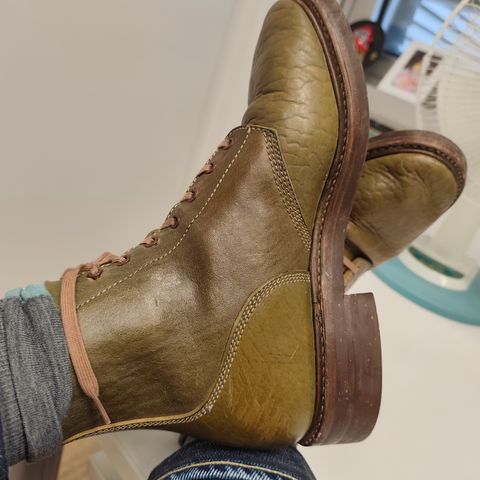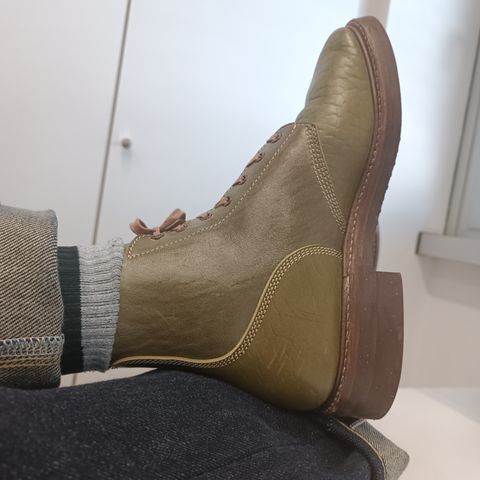About
Shinki Shrunken Horsebutt is a vegetable-tanned horsehide leather produced by Shinki Hikaku, a tannery in Himeji, Japan. The leather features a distinctive shrunken grain texture created through a 10-month pit-tanning process using mimosa bark. Heritage bootmakers use this leather for premium footwear due to its dense fiber structure, durability, and ability to develop patina over time.
About
Shinki Shrunken Horsebutt is a vegetable-tanned horsehide leather produced by Shinki Hikaku, a tannery in Himeji, Japan. The leather features a distinctive shrunken grain texture created through a 10-month pit-tanning process using mimosa bark. Heritage bootmakers use this leather for premium footwear due to its dense fiber structure, durability, and ability to develop patina over time.
The production process requires specialized handling of horsebutt hides, which include the shell portion typically reserved for shell cordovan but are processed differently due to smaller overall hide size. The resulting leather combines the strength characteristics of horse hide with a unique grain pattern that becomes more pronounced with wear, particularly after exposure to water.
Production process
Shinki Hikaku processes horsebutt leather using traditional pit-tanning methods that require a full 10 months from raw hide to finished leather. The process begins with washing, dehairing, and cleaning the hides of fat before they are submerged in tanning pits for two months.
During pit tanning, each hide soaks in a liquor of mimosa bark and water imported from Australia. After soaking, the hides are carefully sorted, dried, and stored for three to four months of natural drying. During this curing period, the hides lose approximately 30 percent of their volume due to shrinkage, which contributes to the leather's characteristic density and shrunken grain appearance.
The pit-tanned process with mimosa bark represents vegetable tanning techniques that Shinki Hikaku has refined since the tannery's founding in 1951. The tannery is the only facility in the world working exclusively with horse hide, giving them specialized expertise in processing these materials.
Material characteristics
Shrunken horsebutt exhibits distinct physical properties that differentiate it from other leather types. The shrunken grain texture provides both aesthetic appeal and functional durability, with denser fibers that create ripples over time, especially after the leather gets wet. The leather maintains the strength, weight, and waterproofness for which horsehide is known.
The material is processed similarly to shell cordovan, containing the shell portion of the hide but manufactured as horsebutt due to the smaller overall size of certain hides. This processing method results in extremely dense horsehide with superior wear potential. The leather's grain and texture remain distinct throughout its lifespan.
An aniline finish allows the leather to develop patina as it ages. The patina development occurs slowly, with a mellow darkening that enhances the leather's appearance over years of use. The dense grain structure adds resistance to wear while maintaining flexibility.
Specifications
Horsebutt leather produced by Shinki Hikaku typically measures 5 to 6 ounces (approximately 2 to 2.5 millimeters) in thickness. This weight makes the leather suitable for boot uppers and accessories while remaining workable for bootmakers during construction.
The vegetable tanning process creates a leather that accepts dyes and finishes differently than chrome-tanned materials. The mimosa bark tanning solution used in production affects how the leather ages and develops character with use.
Available colors
Shinki Hikaku produces shrunken horsebutt in multiple color options for bootmakers. The primary offerings include Shinki Brown Shrunken Horsebutt, Shinki Cognac Shrunken Horsebutt, Shinki Natural Shrunken Horsebutt, and Shinki Olive Shrunken Horsebutt. Each color develops its own patina characteristics based on the base dye and finishing process applied to the vegetable-tanned leather.
Black horsebutt represents another standard offering, providing bootmakers with options for different aesthetic approaches. The oiled horsebutt finish features unique red undertones that become visible as the leather ages and develops patina.
Applications
Heritage bootmakers incorporate Shinki shrunken horsebutt into various footwear styles. Viberg uses the leather for service boots and other models in their lineup. John Lofgren produces multiple boot styles with this material, including Wabash Engineer Boots, Monkey Boots, Medallion Brogue Chelsea boots, Steel Gang Boots, and M-43 Service Shoes, with retail prices ranging from approximately $106 to $1,375 depending on the style.
The leather also finds use in boot accessories such as kilties and tongue protectors. Guarded Goods offers boot kilties made from tan tumbled horsebutt, providing both protection and aesthetic enhancement for heritage boots. The 5 to 6 ounce thickness makes the material suitable for these accessory applications while maintaining appropriate flexibility.
Bootmakers select shrunken horsebutt for projects where long-term durability and aging characteristics are priorities. The leather's ability to maintain its structure while developing character makes it appropriate for boots intended for daily wear over many years.
References
"Shinki Hikaku Tannery". Viberg. Retrieved October 12, 2025.
"The Artisan". Shinki Hikaku. Retrieved October 12, 2025.
"Service Boot - Shinki Horsebutt". Viberg. Retrieved October 12, 2025.
"Shinki Tannery: The Best Leather for Horsehide Jackets". Himel Bros. Retrieved October 12, 2025.
"Boot Kiltie (False Tongue) - Shinki Hikaku Tan Tumbled Horsebutt". Guarded Goods. Retrieved October 12, 2025.
"Shiki Hikaku Horsebutt Collection". John Lofgren Bootmaker. Retrieved October 12, 2025.





































































